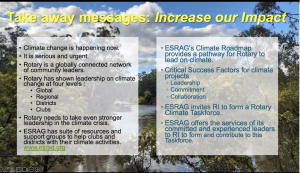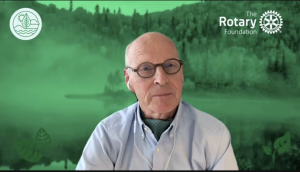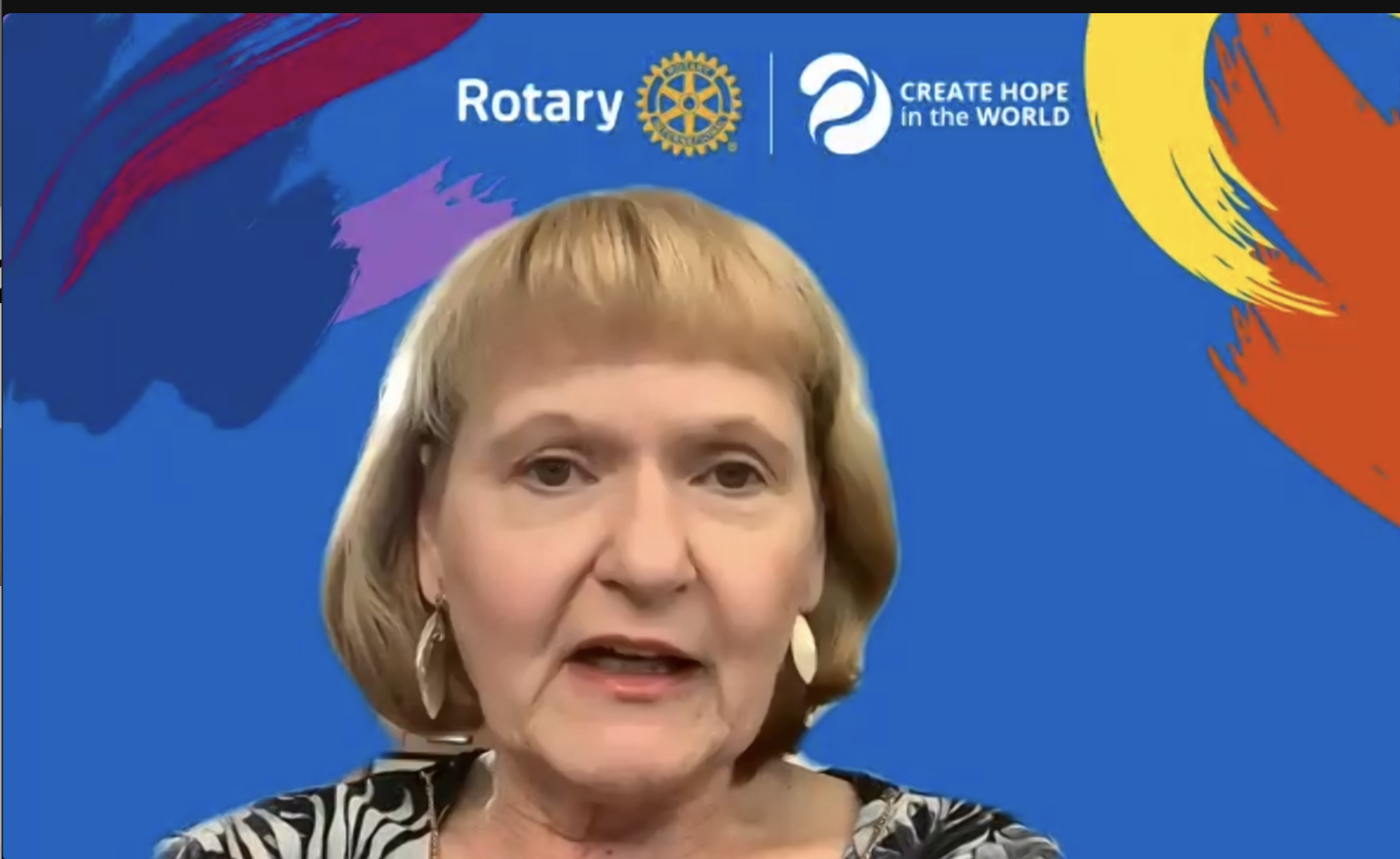Key Take-Aways from ESRAG’s Aug. 26 Forum with Rotary President-Elect Stephanie Urchick
By Yasar Atacik, PhD, ESRAG Chair

Rotary President-Elect Stephanie in dialogue with ESRAG Director Ludwig Kalthoff, MD during the ESRAG-Synergy Forum on Aug. 26, 2023
As massively destructive wildfires and record-shattering heat dominated news around the world, ESRAG welcomed Rotary International President-Elect Stephanie Urchick for the Aug. 26 forum graciously hosted for us by Urs Herzog of Synergy Europe. Our President-Elect affirmed that it’s crucial for Rotary to act on the climate crisis.
Go to ESRAG’s Climate page and scroll down to see the recording of this powerful forum on ramping up Rotary’s climate action.
“We only have one Earth,” RIPE Stephanie said. The peril posed by climate change “isn’t a mystery: it’s all around us.” In dialogue with Rotary’s President-Elect, ESRAG leaders from five continents laid out a roadmap to scale up Rotary’s climate action, combining knowledge and tools we already have at hand. These resources include Rotary’s Four Way Test, Rotary’s Strategic Goals, scientific data on the highest-impact solutions, and the eighteen months of research and consultation that we’ve put into creating ESRAG’s Climate Action Roadmap.
In this article, I’m summarizing ESRAG’s recommendations on how Rotary can rapidly expand our impact in striving to prevent humanitarian catastrophe. Our plan is specific, concrete, and feasible:
- Create a Rotary Climate Taskforce to build commitment at all four levels of Rotary leadership: the RI Board and the Rotary Foundation, regions, districts, and clubs
- Measure the carbon footprint of Rotary activities, and embrace the highest-impact strategies to reduce them.
- Document our behavior changes, environmental projects, and their impacts.
- Align Rotary’s investments to support environmental sustainability.
These steps mirror actions ESRAG is already taking. Our presenters outlined the resources we’ve developed and will help Rotary to implement throughout RI’s global organization and activities. If you are one of the almost 800 people within and beyond Rotary who signed up for the webinar, you’ll soon receive a link to see it online. In this article, I am sharing key points made by RIPE Stephanie and ESRAG’s leadership on how Rotary can mobilize its strengths to maximize our impact in averting climate catastrophe.
 Create a Rotary Climate Taskforce: ESRAG Director Geraldine Nicols of South Africa, who chairs ESRAG’s Climate Action Roadmap Working Group, and ESRAG Past Chair Pat Armstrong of Australia explained our top recommendation to Rotary International. Geraldine and Pat combined powerful first-hand evidence of the havoc already unleashed by climate change with a clear call to action rooted in Rotary ethics and goals. They explained how a Rotary Climate Taskforce will equip Rotary International to walk the talk of its commitment to environmental sustainability and advance all four of Rotary’s Strategic Goals: increase impact, expand our reach, engage clubs, and increase adaptability. Pat showed how climate action is essential if we are to be true to the Four Way Test.
Create a Rotary Climate Taskforce: ESRAG Director Geraldine Nicols of South Africa, who chairs ESRAG’s Climate Action Roadmap Working Group, and ESRAG Past Chair Pat Armstrong of Australia explained our top recommendation to Rotary International. Geraldine and Pat combined powerful first-hand evidence of the havoc already unleashed by climate change with a clear call to action rooted in Rotary ethics and goals. They explained how a Rotary Climate Taskforce will equip Rotary International to walk the talk of its commitment to environmental sustainability and advance all four of Rotary’s Strategic Goals: increase impact, expand our reach, engage clubs, and increase adaptability. Pat showed how climate action is essential if we are to be true to the Four Way Test.

Michael Koch shared this example of carbon footprint calculations by the Rotary Club of Munich-Residenz
Carbon calculators for Rotary: the first step in accountability is to measure the carbon footprint of our own Rotary activities so we can choose the most effective actions to improve it. ESRAG Europe’s Michael Koch, PhD, a mechanical engineer and VP of the BMW Group, described ESRAG’s Become Sustainable initiative using carbon calculators to measure baseline footprint and progress in reducing it. Become Sustainable has already engaged 65 Clubs in Europe, North America, and Africa. Michael will be working with ESRAG’s Oceania Chapter, which pioneered the development of calculators for Rotary Clubs, as well as Rotarians in other regions to provide calculators adapted to the world’s diverse economies and infrastructures. Sharing Project Drawdown data, Michael pointed out that Rotary has the capacity to implement 9 of the top 15 highest-impact climate solutions.
Documenting behavioral change and project impacts: From India, ESRAG Projects Director Mina Venkataraman, PhD, reported on ESRAG’s iRotree app and database which can be used to record behavior changes, projects, and their environmental impacts. “iRotree can be adapted to any project and linked to Rotary databases,” she said. “Club behavior can be added as data.” For tree projects, for example, iRotree can track how much carbon has been sequestered. “Without data, getting collaborations, funding, and greater public credibility is not possible,” she emphasized.
Accountability in our investments: Barbara Zitzmann-Tenglemann, a European economist and architect, called on Rotary International and every Rotarian, club, and district to align our investments with environmental sustainability, as ESRAG has already done by putting our accounts in a green bank. She listed several resources for guiding investment decisions to manage risk and influence business decisions. These range from the European Union’s Green Plan to “ Mensuram Bonam, https://www.pass.va/content/pass/en/news/2022/2022_mensuram_bonam.pdf ” the Pontifical Academy’s Faith-Based Measures for Catholic Investors.
In her speech, RIPE Stephanie strongly affirmed ESRAG’s role as a resource as RI expands its action on the climate crisis. “I’m delighted,” she said, “that Geraldine shared with you how ESRAG’s Climate Action Plan aligns with Rotary’s action plan… which is a living document for us to ensure that we can have a thriving future.”
Here are the ways she sees ESRAG’s Climate Action plan advancing Rotary’s Strategic Goals:

How climate action will increase Rotary’s impact
Rotary’s first strategic goal, increasing impact: “is the priority that reminds us to measure,” she said, commending ESRAG’s Become Sustainable initiative. “As we talk and act more on the environment, younger generations are attracted to our message,” expanding our reach, she added. Environmental action also increases participant engagement by “matching what people are interested in, not just for members, but anyone who comes within reach of the magic of Rotary.” Finally, she cited ESRAG’s dedication to do research and support innovation as increasing Rotary’s ability to adapt. “Examples shown this morning convince me that we know how to do that,” she concluded.
RIPE Stephanie emphasized the importance of continuity, building on the work which ESRAG has already carried out. “We will encourage Rotarians and Rotaractors to consult programs that already have legs, including RAGs with their front-burner projects.”

Jan Lucas Ket, MD spoke about the rapid expansion of environmental global grants and the importance of donating the The Rotary Foundation to increase this impact.
We are profoundly grateful to Synergy Europe for inviting us to hold this forum, and to RIPE Stephanie and past Rotary Foundation Trustee Jan Lucas Ket, MD, for affirming the urgency of Rotary’s taking action on the climate crisis. Both were part of the Rotary leadership who unanimously approved environmental sustainability as Rotary’s seventh Area of Focus in 2020.
We also appreciate ERIC, the multi-district organization for Rotaract Europe, for bringing the new generation of Rotarians into our Become Sustainable work and for sending ERIC VP Katharine Weingärtner as a presenter to our Aug. 26 forum.
I want to thank my fellow ESRAG Directors for the tremendous work they have put into creating our Climate Action Roadmap and organizing the presentations during this webinar, particularly Ludwig Kalthoff, MD, and Laurie Zuckerman, Communications Director. Laurie and her team put in untold hours to get the word out throughout the Rotary world about this webinar. They managed registrations, reminders, closed-caption simultaneous translation, and questions from the audience, and will be providing the meeting recording to all who signed up.
We are thrilled that 784 people registered, representing over 50 nations and territories in Africa, Asia, Europe, the Middle East, North and South America, and Oceania. The vast majority did not identify themselves as ESRAG members, so we’re already succeeding in expanding our reach. We are full of hope that we will be able to use the resources above to accelerate effective climate action throughout the Rotary family and Rotarians’ vital spheres of influence.

This is an essential evolution for human kind. The four way test lays a strong foundation for confidence in collaboration across silos and across the globe. Everything is connected and so are we. And it’s due time we really began acting like it. Look around and see what the us vs them scenarion. One earth, one people one answer. Working together. Starting with 1.4+ million of us.